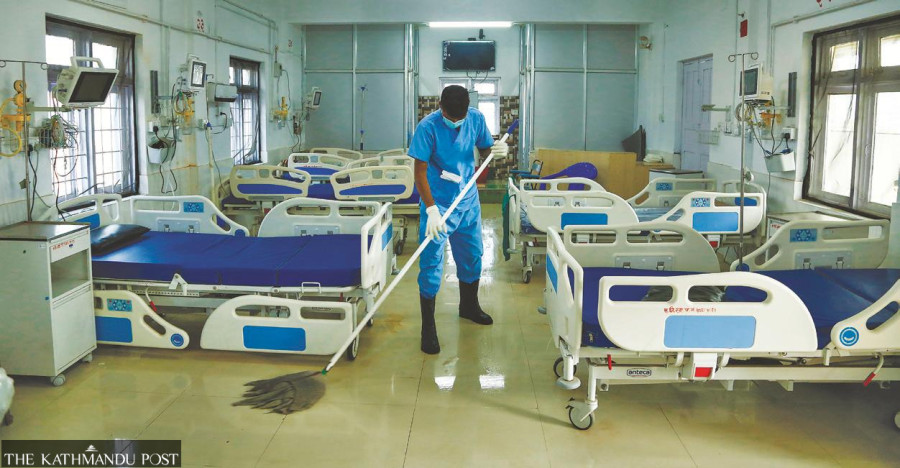Health
BA.5 subvariant responsible for most of new Covid infections
Eight of the 14 swab samples analysed at Dhulikhel Hospital were infected with the subvariant. Experts stress the need to increase booster shots uptake.
Arjun Poudel
The BA.5 subvariant of Omicron has been found mostly responsible for the spread of infections in the ongoing fourth wave of the coronavirus pandemic.
A whole genome sequencing carried out at the Dhulikhel Hospital found the subvariant in swab samples of around 60 percent of the infected people.
The subvariant was detected in eight out of the 14 swab samples of infected people selected randomly, doctors at the hospital said.
The rest of the specimens were found to be infected with the BA.2.75, another subvariant of Omicron, according to Dr Rajiv Shrestha, an infectious disease expert at the hospital.
Whole-genome sequencing is a comprehensive method of analysing the entire DNA sequence of an organism’s genes. Researchers believe that whole-genome sequencing of the coronavirus could be instrumental in tracking the severity and nature of the virus.
In Nepal, five health facilities, including the Dhulikhel Hospital and National Public Health Laboratory, carry out the procedure currently.
The Ministry of Health and Population has already confirmed the BA.5 subvariant of Omicron in Nepal, which dominates the global caseload at present.
Infection of the BA.2.75 Omicron mutant that can evade immunity has also been recorded in the country.
Doctors say the spread of BA.5 subvariant is concerning as its mutations evade the immune system even in fully vaccinated or previously infected people.
“The new subvariants are more infectious than the previous variants,” Shrestha said. “Only the vaccination and previous infection have protected us from getting more severe. If that was not the case, severity from infection wouldn’t have been less than the Delta outbreak.”
The Delta variant of the coronavirus first detected in India caused the second wave of the pandemic which killed at least 8,000 people and infected hundreds of thousands throughout the country.
Along with the BA.5 and BA.2.75, several other subvariants—to name a few, BA.2.73, BA.2.12.1, BA.2.38, and BF.1—have been detected in swab samples of infected people in the past.
On Saturday, two died and 263 people tested positive for coronavirus—162 in 1,399 polymerase chain reaction tests and 101 in 1,766 antigen tests.
Active cases stand at 5,434 in the country.
Of them, only 206 have been placed in institutional isolation. No authority has been monitoring health conditions and movement of the rest of other infected people.
The Health Ministry said that 61 people have been admitted to the intensive care unit; four others, whose conditions are severe, have been placed in ventilator support.
Of the 37 swab samples that underwent polymerase chain reaction tests at Nepal Mediciti Hospital, 17 tested positive.
Despite high positivity rate and spread of infections, authorities have not shown concern to intensify testing, contact tracing, and taking other preventive measures, say health experts.
The National Public Health Laboratory, which has the capacity to carry out over 3,500 polymerase chain reaction tests a day, performed a single test in the last 24 hours.
“When we do not carry out testing and take other preventive measures to prevent the spread of infection, then what is the point of saying these numbers of people get infected daily,” said Dr Sher Bahadur Pun, chief of Clinical Research Unit at Sukraraj Tropical and Infectious Disease Hospital.
“When we carry out less testing and unveil the data, it could mislead people. People might think that the level of risk has declined when they know the number of infected people has lessened.”
Experts urged authorities concerned to focus on administration of booster shots, if they cannot take other preventive measures, including increasing testing, contact tracing, and enforcing public health measures, among others.
“Vaccine prevents severity and lessens the chance of deaths. This is a proven fact and the number of people administered with booster shots is very low in our country,” said Dr Anup Subedee, an infectious disease expert. “Authorities concerned should make every effort to increase uptake of booster shots.”
So far, 74,24,239 people or around over 25.5 percent of the total population have received booster shots.
Doctors say among the reasons for low uptake of booster shots are indifference of authorities concerned to launch the booster dose administration programme, launch awareness drive, and lack of access to immunisation centres.
The Health Ministry concedes that over 75 percent of the total deceased in the fourth wave of pandemic are unvaccinated people, meaning that subvariants of Omicron are not less severe than other variants.
The Health Ministry does not even have proper records of the unvaccinated people or the records of vaccinated people on the basis of the brand of vaccine they received.
Subedi said that it is imperative now that authorities concerned focus on increasing booster shots uptake. “They should also think of administering second booster shots to elderly people and to those having compromised immunity,” he said.




 9.12°C Kathmandu
9.12°C Kathmandu













%20(1).jpg&w=300&height=200)
